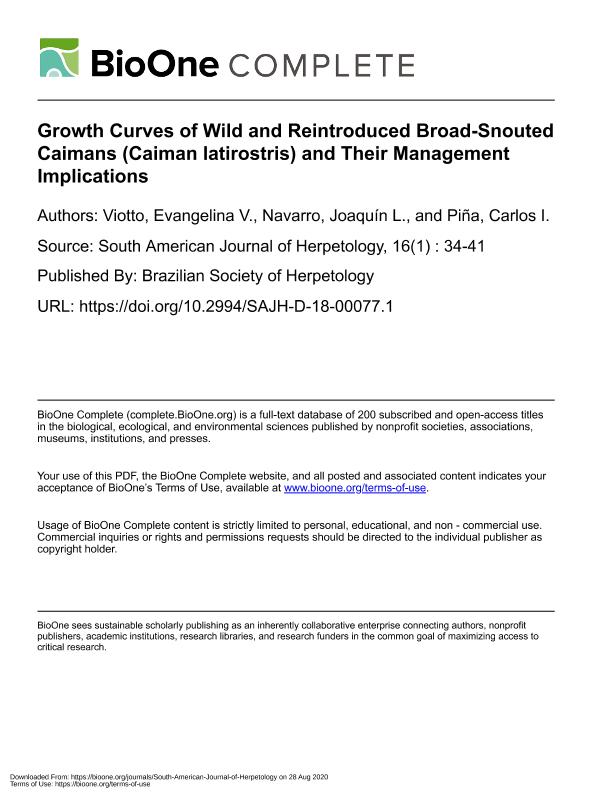Artículo
Growth Curves of Wild and Reintroduced Broad-Snouted Caimans (Caiman latirostris) and Their Management Implications
Fecha de publicación:
08/2020
Editorial:
Sociedade Brasileira de Herpetologia
Revista:
South American Journal of Herpetology
ISSN:
1982-355X
Idioma:
Inglés
Tipo de recurso:
Artículo publicado
Clasificación temática:
Resumen
We describe body growth functions of broad-snouted caimans (Caiman latirostris) for wild and reintroduced individuals. Snout-vent length (SVL, cm) and age of young individuals and adult females were recorded for two different groups: (Py) animals born in the Proyecto Yacaré ranching program, from eggs collected in the wild; and (Wy) wild caimans Class I (< 25 cm SVL) whose age was determined by Size Frequency Analysis, plus females reintroduced by the Proyecto Yacaré and subsequently recaptured at reproductive age. To describe body growth, we adjusted five models through non-linear regression: Logistic, 4-Parameter Logistic (4-PL), Gompertz, 4-Parameter Gompertz (4-G), and von Bertalanffy. Each group was analyzed separately (Py and Wy), and we selected the most parsimonious model based on the Akaike criterion. We also analyzed the possible linear growth difference using ANCOVA. For Py, the Logistic model was best, whereas for Wy the most suitable was 4-PL, in which wild animals would arrive at the inflexion point 1.4 years later on average than in Py. Analyzing the stage at which their development was linear in shape, we detected that the wild animals had a similar growth rate to reintroduced individuals. As a result, although Py animals had experienced accelerated development whilst in captivity, it did not modify their subsequent growth in the wild. The likelihood of survival in this species increases with body size, thus it is important to emphasize that reintroduced animals are larger than wild animals of the same age and that previous farming conditions seem not to affect their growth in the wild. Therefore, we expect that reintroduced caimans will exhibit greater survivorship than natural animals of the same age. Consequently, an adjustment of the current ranching program should be considered, in the sense that population viability could be achieved by reintroducing a lower number of caimans each season.
Palabras clave:
GROWTH MODELS
,
NONLINEAR REGRESSION
,
RANCHING
,
WILD ANIMALS
Archivos asociados
Licencia
Identificadores
Colecciones
Articulos(CICYTTP)
Articulos de CENTRO DE INV.CIENT.Y TRANSFERENCIA TEC A LA PROD
Articulos de CENTRO DE INV.CIENT.Y TRANSFERENCIA TEC A LA PROD
Articulos(IDEA)
Articulos de INSTITUTO DE DIVERSIDAD Y ECOLOGIA ANIMAL
Articulos de INSTITUTO DE DIVERSIDAD Y ECOLOGIA ANIMAL
Citación
Viotto, Evangelina del Valle; Navarro, Joaquin Luis; Piña, Carlos Ignacio; Growth Curves of Wild and Reintroduced Broad-Snouted Caimans (Caiman latirostris) and Their Management Implications; Sociedade Brasileira de Herpetologia; South American Journal of Herpetology; 16; 1; 8-2020; 34-41
Compartir
Altmétricas




